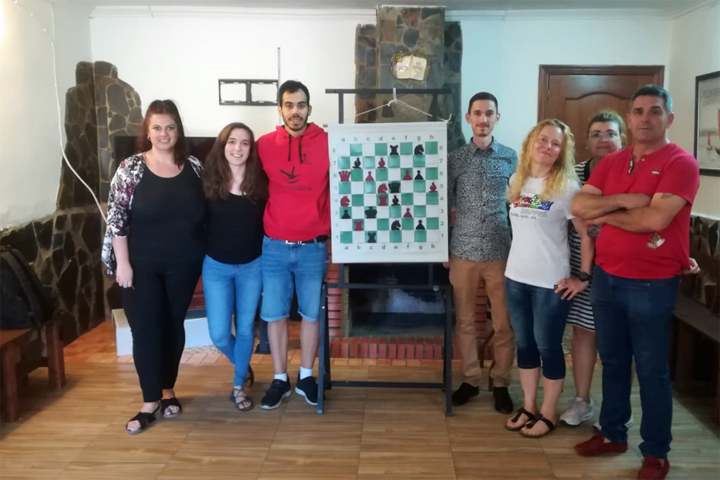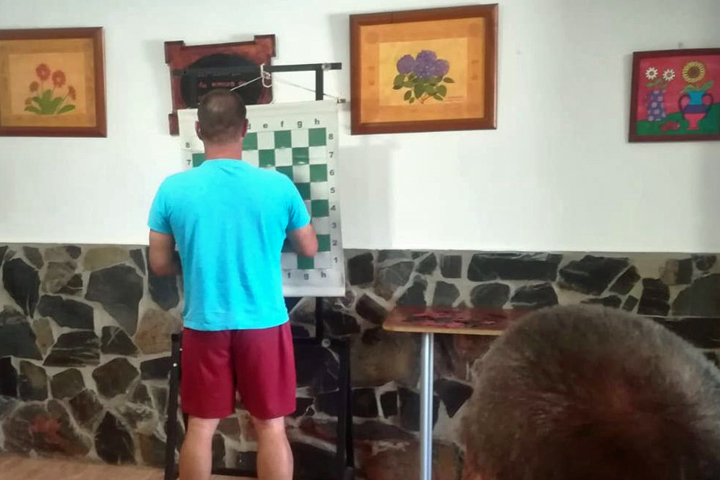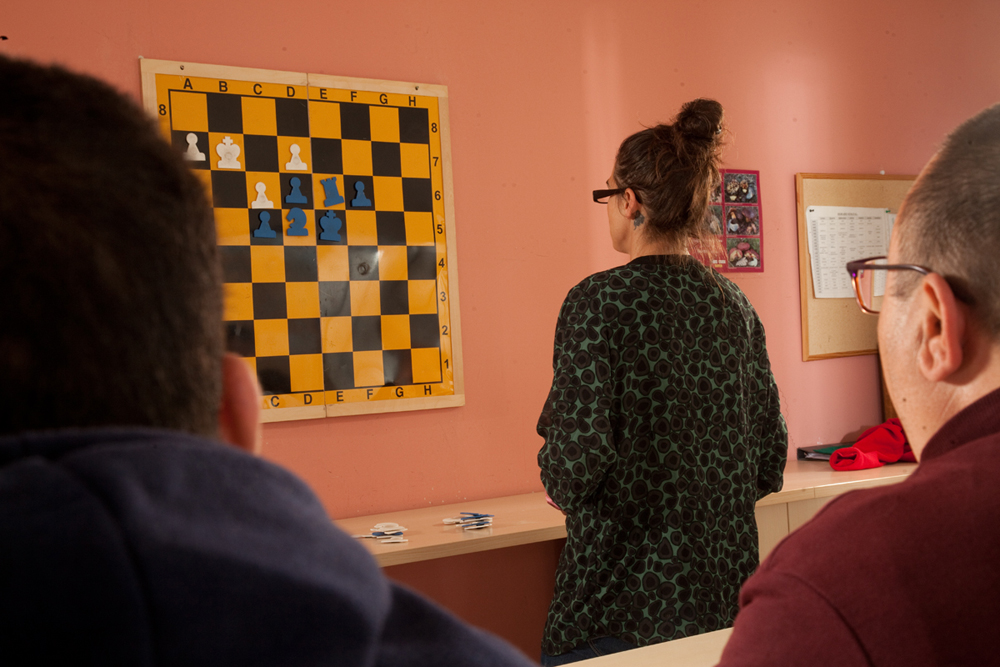


The Therapeutic Community (TC) is a classic concept in addiction intervention that emerged in the United States in the 1950s and 1960s. It is an approach based on peer support and many and varied activities, which in themselves function as a therapeutic intervention.
Today the concept has evolved and many of these communities are located in urban areas. The Club Magic Extremadura Deportivo-Social currently collaborates in two of them: “La Garrovilla” (Mérida) and “Arca de Noé” (Badajoz) — the latter continues to use a traditional approach. In both centres, our club uses its methodology of Cognitive Training through Chess, in this case called “Cognitive Rehabilitation in black and white”, which is supported by the highest official body in Extremadura in the fight against addictions, the Technical Secretariat of Drug Addictions of the Junta de Extremadura.

Leontxo García giving a talk at Garrovilla | Photo: Juan Antonio Montero
We started working in the Therapeutic Communities in 2010, and since then we have not stopped, even in the fateful year of the pandemic. We suspended face-to-face attendance in March 2020, but we adapted quickly, designing a strategy that has allowed us to work remotely by editing videos and preparing series of exercises so that they could continue with the work, which consists of recovering the cognitive functions (attention, memory, etc.) deteriorated by drug use, with the help of chess.

A chess session at Arca de Noé | Photo: Juan Antonio Montero
A decade later, over three hundred people have participated in this program. They have had stays of varying lengths in the centres, with an average duration of 6 months. We provide two one-and-a-half hour sessions per week, which makes for a real intervention-rehabilitation program that meets the most rigorous guidelines. I think this is a great merit for a program based on chess.
Most of the exercises meet the validated parameters for rehabilitation programs. The sessions we teach in the therapeutic communities focus on improving focal attention, divided attention, perceptual discrimination, organization of information, execution of cause-effect actions, logical reasoning, spatial reasoning, working memory, short-term memory, auditory-visual attention and/or memorization skills, etc. Our main working resource is an exhibition board — we do not use individual chessboards. Participants in the sessions can only use their brains, although sometimes they are invited to solve exercises on paper.

Working on recovering cognitive skills | Photo: Juan Antonio Montero
In each session, one or two specific cognitive skills are selected. Sometimes several of them may coincide in a single exercise, as in the case of executive functions in an exercise where they have to solve how many moves are necessary to return a number of pieces to their original squares.
Cognitive skills are put into practice in each part of the session. For example, we could spend one part of the session doing a working memory exercise with a position in which there are four pawns on the board. They are given 1 or 2 minutes to memorize the position and must reproduce the position one by one on the board. Their initial success is used to motivate them and increase the difficulty, adding pieces, one by one, to the initial position, until a chess position with a larger number of pieces is presented.
In the second part, we could focus on another skill and perform an attention exercise, placing different pieces in the centre of the board and asking direct questions about piece counting and discrimination: how many pawns there are, how many knights and bishops on light squares, how many white knights and bishops on dark squares, how many black rooks on light squares, and so on.
The program never stops — it is active all year round, and it is not a standard course. It is a complementary therapy to the ones developed in the centre and, as I already pointed out, the objective is to recover cognitive capacities (attention, memory, executive functions, logical reasoning, perception) deteriorated after many years of exposure to addictive behaviours.

Carmen Quesada, Juan Antonio Montero and Leontxo García | Photo: Juan Antonio Montero
There is no beginning, no “first session”, as there is no “final session”. We do not go through levels 1 to 10, as if we were following a syllabus. It is not like that. There is a progression and a scale of difficulty that helps us to plan the work for each week, depending on the degree of cognitive deterioration and how long the participants have been working in the program, among other factors. It is always possible to start “from scratch” (the simplest exercises in each cognitive area) recurrently throughout the program.

Helping deal with addictions | Photo: Juan Antonio Montero
In that sense, our work is circular. We start by getting to know the interests of the participants: what they know about chess beforehand and whether they are familiar with these modern methodologies — the pure and traditional game is not usually explored, although some participants know a bit about the game from the start. After several weeks, others get into the rhythm of solving the exercises, with some achieving real feats such as memorizing the position of more than 20 pieces in a single session. After a while they move on to other activities or leave the program, and we start again with new participants.
At the end of the day, we remain there while many participants enter and leave the centres. Some decide to stay and work as volunteers in the centres, and become an essential support for the newcomers, bearing in mind that many only think of chess as an intellectual challenge that is unassailable for them — which is not the case. That is why the work on motivation and self-esteem is also part of this rehabilitation “in black and white”.
Four hours a week are dedicated to reversing the effects of prolonged years of addictive behaviour, so that the participants can resume a game which, despite not having all the pieces in place, can still be won.